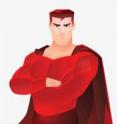The science behind the cape
What do you have when you line up a martial artist, acrobatic gymnast, police officer, firefighter, NASCAR driver, and NFL running back? "Watson," the IBM super-computer that recently routed humanity's best on Jeopardy might have guessed the answer was "the Village People," to which host Alex Trebek could have replied, "Sorry. The answer we were looking for is 'Batman'." At least that is the correct answer for physiologist E. Paul Zehr. In a new article, Zehr, a professor at the University of Victoria, Victoria, British Columbia, describes his success in using the Caped Crusader to engage students in the study of physiology.
"Batman has such powerful resonance with readers because he is a (fictional) human with superpowers that seem within reach if we only work at it," writes Zehr in a new article published in Advances in Physiology Education, a journal of the American Physiological Society. Zehr believes that it is not Bruce Wayne's vast wealth that allows him to protect the citizens of Gotham City, but his dedication to developing a wide range of physical skills.
Zehr uses Batman to establish a framework, grounded in his fictional universe as well as our real one, in order to discuss the various components of exercise and physical training and illustrate how the body's physiological systems respond. His experiences in teaching undergraduate courses in physiology and neurophysiology made him realize that connecting science to popular culture helped students understand the lessons better.
He first presented a formal analysis of the personal and physical discipline that would be required to transform an ordinary mortal into a superhero in his book, Becoming Batman: The Possibility of a Superhero. The book drew on Zehr's understanding and work in human locomotion and the plasticity of nerves and muscles associated with exercise. By coincidence, the book was published in the wake of The Dark Knight, the blockbuster movie which recounts Batman and his arch-enemy, the Joker.
With the casting almost complete for the sequel, The Dark Knight Rises, Dr. Zehr writes about his experiences connecting science to popular culture, which is captured in the Advances, article, "A Personal View: From Claude Bernard to the Batcave and Beyond: Using Batman as a hook for physiology education."
Batman: A Catalyst for Understanding Science
In the article, Zehr writes that far more Americans are aware of Bruce Wayne, the man behind the Batman mask, than Claude Bernard, a 19th century French physiologist who first established the use of the scientific method in medicine. Dr. Zehr certainly knew of Bernard, because for over 17 years he has published more than 70 scientific paper and hundreds of abstracts associated with his research into physiology and the science of body motion.
While Bernard used the tools of his day to explain science, Zehr says that Becoming Batman was the catalyst to adopting a new approach to his research efforts in neuroscience and human neurophysiology. The science of Batman is hardly, "silly science," as some might suggest, because the physiology behind Batman is the physiology of us all.
"The more that people understand science, and the physiology of things in particular, the better for everyone," says Zehr. To that end, he has written a second book in this genre, Inventing Iron Man: The Possibility of a Human Machine, to be published later this year. Will he use a cyborg -- like the one best represented by Arnold Schwarzenegger in Terminator 2: Judgment Day (T2) – to explain science? The author, like Batman smiles enigmatically and says, "You will have to wait and see."
Source: American Physiological Society
Articles on the same topic
- The science behind the capeWed, 9 Mar 2011, 4:42:09 UTC
Other sources
- The science behind the cape: How one physiology researcher is using batman to put some POW! Into physiology studiesfrom Science DailyWed, 9 Mar 2011, 2:30:18 UTC
- The Science Behind the Capefrom Newswise - ScinewsTue, 8 Mar 2011, 23:00:33 UTC
- The science behind the capefrom PhysorgTue, 8 Mar 2011, 22:30:40 UTC
